Crisis communication can make or break a brand’s reputation, whether it’s a product recall, a data breach, a natural disaster, or a public relations nightmare. This is where the power of a strong press release comes into play.
What is a crisis press release?
A crisis press release is a formal written statement issued by an organization in response to a significant and potentially damaging event or situation that could negatively impact its reputation, stakeholders, or operations.
A crisis press release aims to assert control, clarify the situation, and assure stakeholders of the organization’s commitment to effectively managing and resolving the crisis.
In this article, we will guide you through crafting a crisis press release, provide valuable insights, and showcase real-life examples of crisis press releases.
We’ll cover:
- How to find relevant journalists for your crisis press release
- How to write a crisis press release
- When to write a crisis press release
- What are the questions to answer in a crisis press release
- How to distribute a crisis press release
If you’re short on time, Prowly provides press release templates that allow you to craft your own crisis press release effortlessly in a format that meets journalists’ expectations.
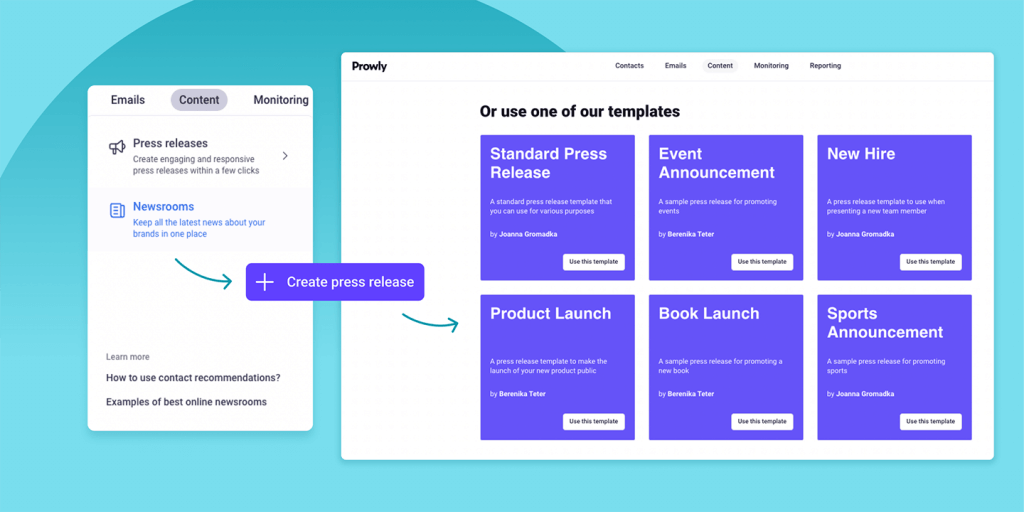
How to find relevant journalists for your crisis press release
Even the best-written press release will not have any effect if it doesn’t get to the right journalists who will ensure its publicity.
To catch media attention and repair the company’s PR crisis you should communicate your statement to a wide audience. How do you get it done?
First, go to a media database, as provided by Prowly, and find journalists who may be interested in a new release such as yours. Using the “search by keywords” feature, you can identify journalists who have written articles similar to yours.
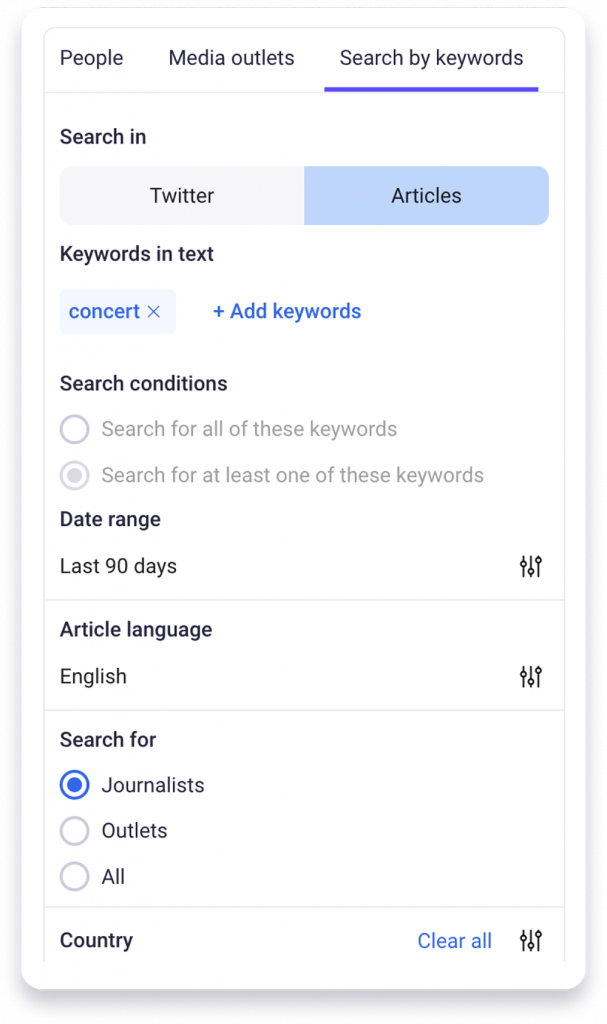
Filter authors by location or interests in specific topics or industries to enrich your search and get relevant journalists who are likely to be interested in your story. This should be one of the most deeply considered steps of your crisis communication plan.
How to write a crisis press release
Crisis press release format
Although crisis press releases share a format with other press releases, they have unique elements that distinguish them, particularly in content and messaging.
- Immediate response: A crisis press release must be proactive and swift, ensuring timely communication with stakeholders. It’s crucial to address the issue at hand promptly, even if all the details aren’t available yet.
- Transparency: Unlike other press releases, which may primarily aim to promote or inform, a crisis press release prioritizes transparency. It should provide a truthful account of the event, acknowledging errors or mishaps.
- Detailing the crisis: The crisis press release must clearly outline the nature of the crisis, its impact on stakeholders, and any potential disruptions to regular operations. This detail-oriented approach differs from other press releases that may focus more on highlights or key selling points.
- Resolution plan: An action plan is critical to any crisis press release. It must contain information about how the organization plans to manage and resolve the crisis, demonstrating a commitment to rectifying the situation.
- Reassurance: Lastly, the crisis press release should reassure stakeholders. This can be effectively accomplished by emphasizing the company’s dedication to its values and stakeholders, thus fostering trust and confidence amidst the crisis.
These unique characteristics make crisis press releases a specialized tool for crisis management, demanding careful consideration and strategic planning.
The elements of a crisis communication press release include:
- Headline: Your headline should be concise and convey the crux of the crisis. Constructing it in a way that immediately informs the reader about the nature of the crisis is vital.
- Subheader/Lead: This serves as a summary of the crisis. It should provide key details and be written in a news-style format to inform the reader of the basic facts quickly.
- Dateline: The dateline indicates when the press release is issued. This is crucial in a crisis as it provides the reader with a timeline of events.
- Body: The main part of the press release should give a comprehensive overview of the crisis. It should explain what happened, its impact, and what actions are being taken to address the situation.
- Quote: Including a quote from a key figure in the organization, such as the CEO, adds a personal touch and provides an opportunity to express empathy, take responsibility, and reassure stakeholders.
- Logo and Media Contact Information: Including your logo personalizes the press release and reinforces your brand identity. Media contact information is crucial during a crisis, as journalists may need to reach out for further information or updates.
Read more about each element of a press release in our recent post: How to Write a Press Release (With Tips From PR Pros).
Crisis press release examples
You can use several crisis press release examples as inspiration or as a template.
Shenandoah Telecommunications crisis communication press release example
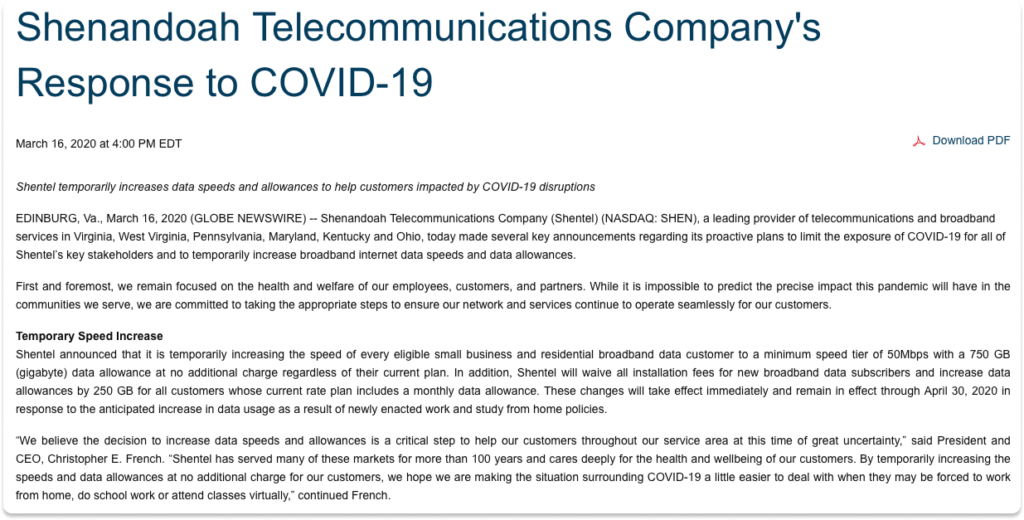
Johnson&Johnson crisis communication press release

Nike crisis communication press release example
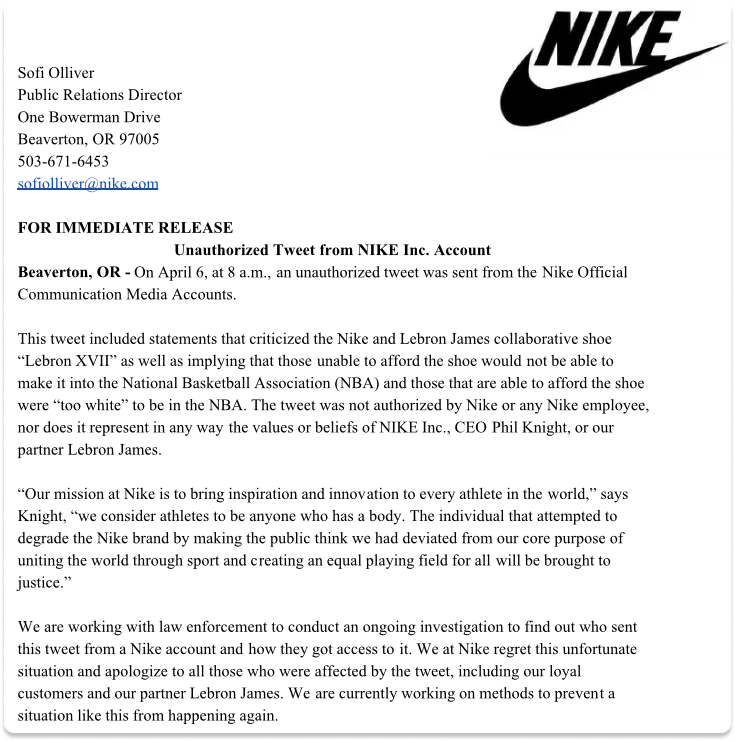
The above sample press releases for crisis management can be your benchmark while creating your company’s crisis communications.
Crisis communication press release template
As we covered press release examples for crisis management, now it’s time to share some practical tips. Below are some ready-made templates that can speed up the creation of your crisis press release.
With this dose of help, you can create your own crisis management press release template that you can follow whenever a problem arises. Hopefully, not so often.
Prowly’s press release creator tool offers a range of templates designed to cater to different types of press releases. Whether it’s a product announcement, new hire, or event announcement, our tool makes it convenient for media outlets to utilize your release.
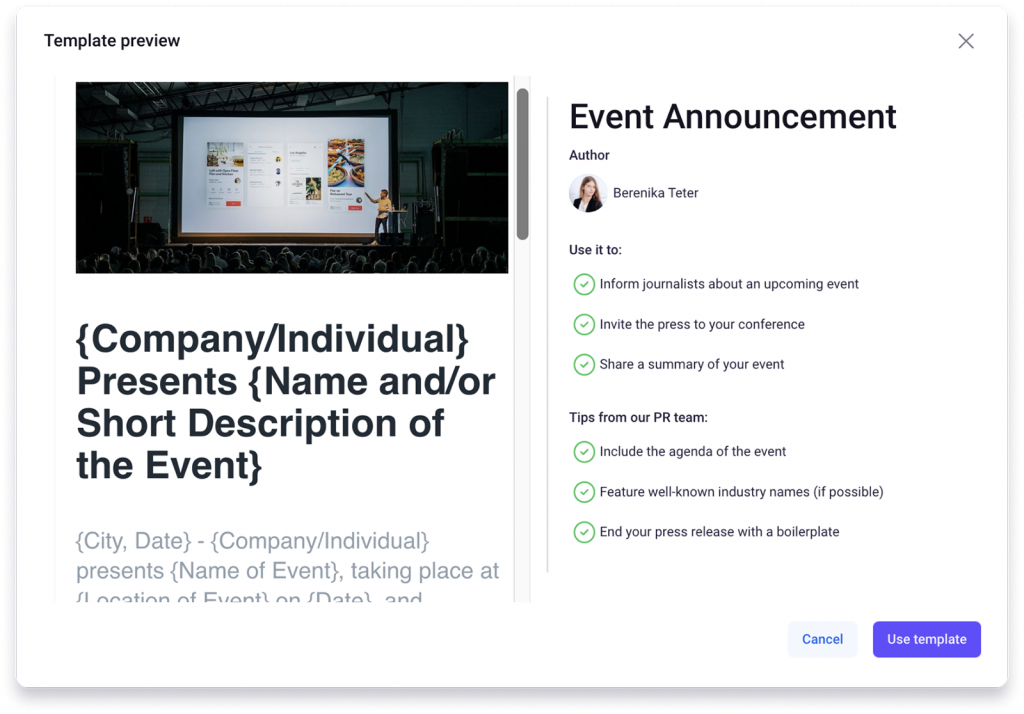
Start your free 7-day trial of Prowly and utilize it as a valuable tool for your crisis communication press release template, gaining access to Prowly’s exclusive templates.
When to write a crisis press release
In the world of crisis management, timing is of the essence. The decision of when to draft and release a crisis press release can significantly influence the outcome of a challenging situation. It’s a strategic move that requires careful consideration and precise timing.
After what kind of event should a crisis communication press release be the first thing on your to-do list?
Accusations
These are common scenarios on the market. Companies often face scrutiny and accusations in various situations. These include dealing with defective products that bypassed quality control or grappling with management failures that had significant consequences.
Public scandals
You may initially think of celebrity scandals, but companies can also face situations that damage their reputation. Corporate scandals can take various forms, including controversial financial decisions or misuse of authority by the leadership team, leading to ethical and legal issues.
Lawsuits
Legal trials can negatively impact a company’s PR, regardless of whether it assumes the role of plaintiff or defendant. Involvement in a legal dispute can damage a company’s reputation with stakeholders, even without significant media coverage. Such situations cast shadows over a company’s reputation, erode trust, and raise questions about its ethics and operations.
Disasters
The pandemic has been a real eye-opener, reminding us that the world can be quite unpredictable and knows how to shake up the market. When disaster strikes, it can throw a curveball into your company’s operations in various unexpected ways – think production hiccups, supply chain roller coasters, and the occasional product shortage.
Failures
Everyone makes mistakes – it’s just part of being human. But sometimes, these slip-ups can lead to big problems, like product contamination or using the wrong labels. These mistakes can damage a company’s reputation and, in some cases, even put consumers at risk.
All of the above situations demand clear and quick communication from a company. As proof of such incidents, you could read pieces of sample crisis press releases referring to the above events.
What are the questions to answer in a crisis press release?
How to write a crisis communication press release that will deliver a clear message to the audience? The message should be as informative and as objective as it can be.
In crisis management, creating judgment in a crisis simulation press release is pivotal to maintaining transparency and in managing public perception during challenging times.
Considering the press release crisis management example we gave you above, let’s cover the main questions you should answer in your press release for a crisis.
Let’s start with the general press release rule, the “5Ws”:
- Who? Define who the crisis relates to – a single employee, a department, or the whole company.
- What? Message your crisis statement – what you know and what you have done to extinguish the fire.
- When? Set the time frame.
- Where? Communicate the locations that this event will or may affect.
- Why? Explain the company’s decision to take specific action in response to the crisis.
Following the company crisis press release example from the previous paragraph should help if you need more support.
What assistance can you offer to those affected?
Every crisis affects someone — customers or employees. It doesn’t always have to involve direct harm, but it’s important to ensure their well-being. Keep your company resources in mind and make promises you can keep. Otherwise, your audience’s trust may erode.
Was your company to blame for it?
If so, be transparent and explain what happened. Describe what led to the crisis and take responsibility for the situation without being defensive in your communication. This way, people will find it easier to relate to your message and, in the future, trust you again.
How to distribute your crisis press release
Once you’ve created your crisis press release sample, it’s time to send it out to the world. Here are some ways to do so.
Pitching your press release
Pitching relevant journalists by email is considered one of the most effective ways. Its success depends on the accuracy of your media list.
Prowly’s Media Database grants you access to an extensive network of over 1 million media contacts. These contacts can be sorted based on beat and location, ensuring convenience and precision in your media outreach efforts.
Prowly also provides smart recommendations based on the content of your press release. This saves you time on media research and ensures you connect with the most relevant journalists for your story.
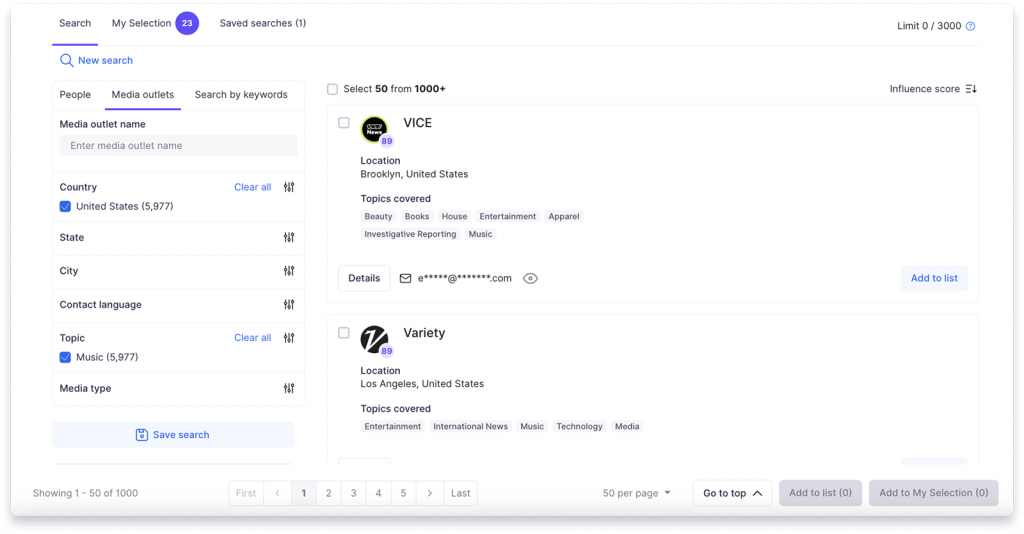
Utilize email personalization
You’ll get a better shot at getting a journalist’s attention if you write a personalized pitch for them. A customized pitch considers what topics they usually cover, what they’ve written on in the past, some big news they’ve covered, or releases you’ve previously sent them.
Do you need a hand? Prowly’s 1:1 email personalization is at your disposal. Enabling you to generate media lists for your campaigns and compose individual emails as required.
This tool assists in customizing every element of your pitch, from the initial greeting to attachments. Such a high degree of personalization elevates your press coverage, guaranteeing that your press release for a crisis connects effectively with the intended audience.
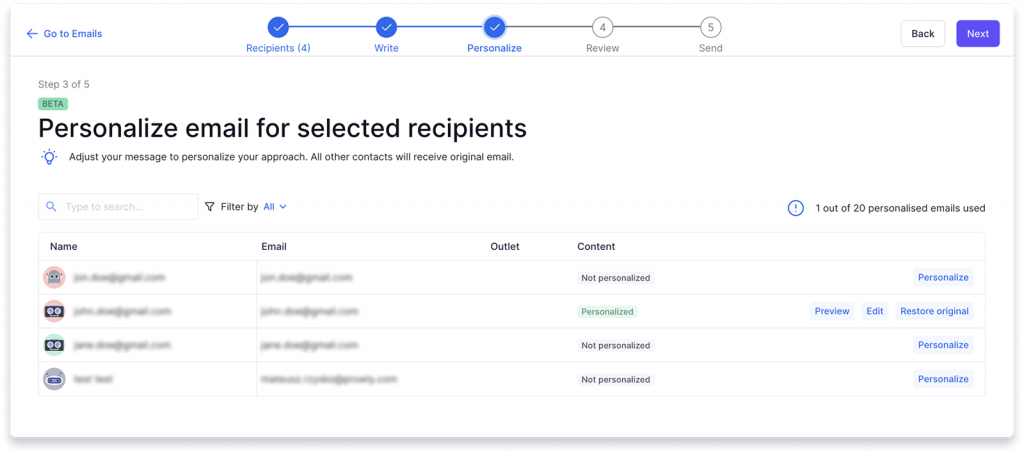
Follow up
Now that your press release is in the wild, it’s time to shift your focus to follow-ups – but with a relaxed approach. Be patient when reaching out again, allowing journalists to check your initial email.
We know that time isn’t your biggest ally when a crisis hits. But remember, sending your crisis press release sample to various types of media improves your chances of being published. And helps you avoid following up too many times in a short period.
Alternative: using a wire service
Wire services provide another common method for sharing your press release. It can be faster than pitching, but it may come with a higher price. You might come across specialized industry media or free news or gossip portals.
However, be aware that the quality of media coverage obtained through wire services may not always meet your expectations. Ultimately, your most reliable approach is still personally connecting with your media contacts.
Conclusion
The importance of press releases during a crisis is huge. Moreover, responding swiftly and effectively to a crisis can make all the difference in safeguarding your organization’s reputation and maintaining stakeholder trust. We have shown you crisis management press release examples and tips for crafting such a piece.
Feel free to use the Prowly’s Press Release Creator while crafting your crisis press release template and use a media database to find the journalists you need.


